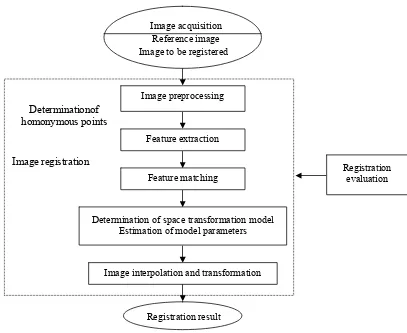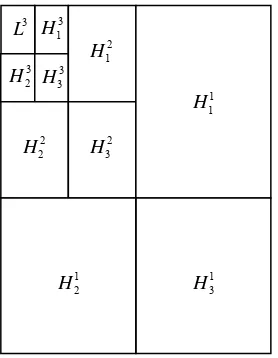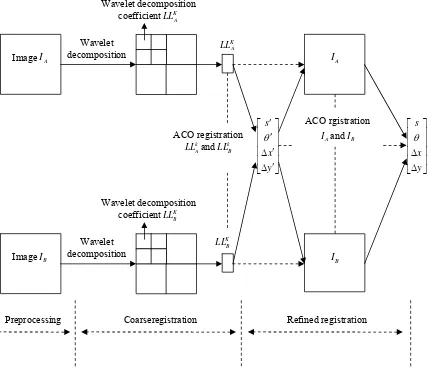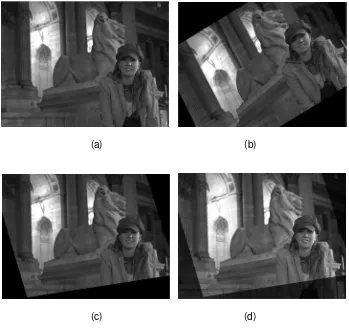DOI: 10.12928/TELKOMNIKA.v13i2.1432 604
An Image Registration Method Based on Wavelet
Transform and Ant Colony Optimization
Dapeng Zhang1, Jiayan Li2*
1
Information Engineer Department, Henan Vocational and Technical Institute, Zhengzhou 450046, Henan, China
2
Educational Administration Department, Henan Vocational and Technical Institute, Zhengzhou 450046, Henan, China
*Corresponding author, e-mail: [email protected]
Abstract
Image registration, as one of the basic tasks of image processing, is the process to register two images about the same objective or background which are acquired in different times, different sensors, different perspectives and different shooting conditions. In the image registration, because of the problems that the image information is complicated, they have strong correlation and incompleteness, inaccuracy and non-construction occur in different levels in the processing, to apply the method of computational intelligence information processing in the image registration can have better results than the traditional computation methods. This paper proposes an image registration method based on wavelet decomposition and ant colony optimization, which divides the process of image registration into coarse registration and refined registration through wavelet decomposition technique. In the coarse registration, the transformation parameter value of the image approximation component is acquired through ant colony optimization while the changing parameter value of the original image is obtained by the ant colony search method in the refined registration. The simulation experiment shows that this registration method has the characteristics of anti-noise, fast speed, high accuracy and high registration success rate.
Keywords: Image Registration, Wavelet Transform, Ant Colony Optimization
1. Introduction
The images acquired by different sensors or by the same sensor in different times and perspectives are usually different, which is bad for the target detection system, the computer vision system and the image fusion and which will make the system generate error information of the target [1]. The process to eliminate the difference is called image registration. The basic problem of image registration is to propose an image transformation method to be used to correct the coordinates and deformation of the image. For example, the images of the same scene taken at different times or by different sensors from different perspectives may have some translation and rotation and they are in different coordinate systems; therefore, they need to be corrected. There are many reasons causing the image deformation. For instance, in the remote sensing image, the sensor noise, the changes such as the deformation, movement or growth of the objects to be taken, atmospheric change and lightning as well as cloud coverage and shadow may result in deformation of different forms in the image. The different causes and forms of image deformation have required different corresponding image registration techniques [2].
complicated and the application has huge restrictions. Instead of directly operating on the image gray, the feature-based method tends to extract control structure in the feature space and realize image registration. With the development of computation intelligence, intelligent algorithms are increasingly used in image registration and play an important influence on the effects and efficiency of the image registration [5].
With the feature-based image registration as the foundation, this paper improves such method by integrating wavelet analysis and ant colony optimization so as to expand the application range of the matching algorithm and make the matching effects more outstanding while preserving its original performance. Taking the mutual information as the similarity measure of the image registration, it can automatically adjust the transformation parameter scopes of coarse registration and refined registration and it has a bright application prospect as a universal fully-automatic image registration method. This paper first explains the principle and mathematical model of image registration as well as the registration method based on features; then it proposes the basic workflow of fully-automatic mutual-information image registration according to wavelet theory and ant colony optimization and its final part is the simulation experiment and analysis.
2. Principles of Image Registration
2.1. Definition and Mathematical Model of Image Registration
Image registration is the process to match, overlay or process two or more images of the same scene acquired at different times by different sensors (imaging devices) under different conditions (weather, illumination, camera position and angle) and it is a fundamental problem of image processing.
Two images of the same scene taken under different imaging conditions may be different in deformation and rotation. Image registration is to make the images with different gray scales and geometric transformation into the images with consistent gray scale and geometry. Assume that the two-dimensional arrays f x y1( , ) and f x y2( , ) stand for the gray-scale values of the corresponding grid positions in the two images, then there exists such a transformation relation between the two images.
2( , ) ( ( ( , )))1
f x y g f h x y (1)
In this formula, g is the grayscale or radical transformation function and h refers to the two-dimensional coordinate transformation. According to the property of affine transformation, its affine transformation model is:
cos sin sin cos
x x x
y y y
(2)
In this formula,,xand yare the registration parameters of these two images.
2.2. Types of Image Transformation
The most fundamental problem for all image registration techniques is to find out the proper image transformation or mapping type to match two images correctly. After the consistency of the image feature is established, the matching function is also established. We hope to transform the observance image to make it register with the referenced image. Therefore, the design of mapping function shall consider and get closed to the consistent control points of the observance image and the referenced image as much as possible.
1) Rigid-Body Transformation
2 1
If the transformed straight line in the first image remains the straight line when mapped in the second image and maintain an equilibrium relation, such transformation is called affine transformation. Affine transformation can be divided into linear (matrix) transformation and translation transformation with a transformation formula as follows:
2 1 The more common two-dimensional affine transformation formula is as follows:
13
If the transformed straight line in the first image remains the straight line when mapped in the second image but the parallel relationship maintains the same, such transformation is called projection transformation, which can be shown by the linear (matrix) transformation in high-dimensional space. Its transformation formula is:
11 1 12 1 13 21 1 22 1 23
Non-linear transformation can transform straight line into curve. In the two-dimensional space, it can be expressed by the following formula:
( ,x y ) F x y( , ) (7)
In this formula, F refers to any function form to map the first image to the second image.
2.3. Feature-based Image Registration
The methods of image registration can be divided into two kinds: grayscale-based method and feature-based method. As the most frequently seen method, the feature-based image registration selects the features which can be easily extracted and which can represent the similarity of the images to be registered as the registration basis for the images with different properties.
Figure 1. The flow chart of image registration
3. Wavelet Analysis 3.1. Mallat Algorithm
Mallat algorithm (namely the two-scale equation) is the most fundamental characteristic the multi-scale analysis gives the scaling function ( )t and the wavelet function ( )t and it describes the internal relationship between the two neighborhood scale spaces Vj1 and Vj or between the basic functions of the neighborhood scale space Vj and the wavelet space Wj.
( )t
and ( )t can be expanded linearly with the orthogonal basis1,n( )t of the
1
V space.
0 1, 0
1 1, 1
( ) ( ) ( ) 2 ( ) (2 )
( ) ( ) ( ) 2 ( ) (2 )
n
n n
n
n n
t h n t h n t n
t h n t h n t n
(8)Here, the expansion coefficients h n h n0( ), ( )1 are h n0( ) , 1,n , ( )h n1 , 1,n and they are determined by( )t and ( )t , which have nothing to do with the specific scale.
Project any f t( ) to the spaces of Vj, Wj respectively and get the following:
_ _
2 2
, ,
( ) 2 (2 ) 2 (2 )
j j
j j
j k j k
k k
f t
c t k
d tk (9)Image registration
Registration evaluation Determinationof
homonymous points
Image preprocessing
Feature extraction
Feature matching
Determination of space transformation model Estimation of model parameters
Image interpolation and transformation Image acquisition
Reference image Image to be registered
, , ,
Generally, cj k, ,dj k, are called the scaling coefficient and wavelet coefficient. Formula (10) describes that cj k, ,dj k, in the jspace can be obtained from the weight sum of the scaling coefficient after the filtersh n h n0( ), ( )1 in the scale space of j1and they can be expanded to any scale space if decomposed continuously [7]. As indicated in Figure 2, the reconstruction formula is:
1, , 0( 2 ) , 1( 2 )
j m j k j k
k k
c
c h m k
d h m k (11)Figure 2. Wavelet decomposition diagram
3.2. Image Wavelet Decomposition and Reconstruction
As a multi-scale image geometric analysis tool, wavelet transform has excellent space-domain and frequency-space-domain locality and it has been widely applied in the image fusion. Wavelet decomposition and reconstruction is to use two one-dimensional filters to realize the fast wavelet decomposition of two-dimensional image and then realize the image reconstruction with two one-dimensional filters. Figure 3 is the diagram of the image after three-level wavelet decomposition [8].
Figure 3. Three-level image wavelet decomposition diagram
Here, Lis the low-frequency part of the image and it gathers its main energy. And
1, 2, 3, ( 1, 2,3)
j j j
H H H j are the high-frequency components in the horizontal, vertical and diagonal directions in the jthlevel. They are the image details.
4. Basic Implementation of Ant Colony Algorithm
Ant colony algorithm is first used to solve the traveling salesman problem (TSP). TSP problem refers to the problem in terms of the shortest path when traveling salesman iterates through all cities in one certain area. In order to illustrate the thought of this algorithm more conveniently, we still take the solution of traveling salesman problem consisted by n cities on the flat surface as an example to analyze the basic principle of ant colony algorithm. For other forms of optimization analysis, the corresponding optimization algorithm will be modified and obtained on the basis of such problem.
First of all we should make some assumptions in terms of the ant search environment and also set some specific parameters:
Set b ti( ) as the ant number existing at moment t by element i;ij( )t the pheromone concentration value at moment t on the path( , )i j ; n the city number in TSP and m the scale of the ant algorithm, i.e. the total ant number among the ant colony, and
1 the initial time of the ant colony algorithm, pheromone on each path is usually set as a constantij( )t c. During the search process on the path of the ant k k( 1, 2,, )m , its next
search path will be determined by the pheromone concentration on different paths. P tijk( ) stands
for the selection probability of the ant k transfers to element (city) j from element (city) iat the moment t.
In which, allowedkstands for the city allowable to be selected by ant k in the next step,
is the pheromone intensity impact factor, which stands for sensitive degree by the ant to pheromone concentration and also shows the relative importance of this path, and the larger its value is, the more vulnerable the ant is to the impact of the pheromone concentration when selecting the next search path. The ant is more vulnerable to select the path with higher pheromone concentration, i.e. the path that has been walked by more ants. In this way, the communication information among ants is also enhanced to make the coordinating mechanism more obvious. refers to the visibility factor, namely the expectation factor, which shows the importance of the ant’s own visibility to the path selection, and the larger its value is, the more dependent the ant on the visibility information when selecting the path. When the value is very large, the ant will select the next search path by an almost greedy rule but ignoring the impact of the pheromone. ij( )t is the heuristic function and its expression formula is as follows:
1
In which, dij stands for the distance between two adjacent elements. The smaller dijis , the closer the distance between two cities, meanwhile the larger the ij( )t is, the larger
k ij
is, the larger the probability of the ant selects such city in the next step is, that is to say, this function shows the expectation degree value of the ant from one city to another.
With the constant search of ants, pheromone will be left on a lot of paths. In order to prevent that the constant accumulation of large residual pheromone on each path causes the ant to ignore the visibility information, the residual pheromone amount on each path should be updated when every ant completes one search step or the ant finishes searches of n cities (i.e. one iteration of the algorithm is completed).Thus, the pheromone concentration on path
i j, at the moment tn can be adjusted according to the following formula:
+ 1
In which, represents the pheromone volatilization factor, 1the pheromone residual factor. In order to get closer to the ant group in the nature and prevent the excessive accumulation of the pheromone, and usually 'svalue scope is
0,1
. After one iteration is search process. In the ant colony algorithm, the updating strategy of pheromone directly determines the algorithm’s efficiency and success, and the updating strategy of the pheromone is decided by the problem features to be resolved [9],[10].5. Image Registration Process Based on Wavelet Analysis and ACO
The mutual-information image registration process based on wavelet decomposition and ant colony optimization includes three phases: pre-processing, coarse registration and refined registration. The core task in the coarse registration is to quickly determine the local scope of the optimum value of the image registration parameter. In order to overcome the shortcoming that the image registration method based on mutual information has huge computation, the computation in the registration can be reduced through wavelet decomposition in the coarse registration. After that, ant colony optimization can obtain fast convergence from the relatively wide search scope. It is automatic and universal. The result of the coarse registration can be the initial parameter to be optimized in the refined registration and the local scope of refined registration parameter can be determined according to the accuracy of the image to be registered. When entering in the refined registration, we adopt the mutual information as the measure of the image registration. Its essence is to search the registration parameter under the maximum mutualinformation. Since the mutual information of two images has local extremum in the search spatial scope and the computation is large, global optimization is needed to increase the registration speed. In here, refined registration is realized by using ant colony search method.
The steps of the fully-automatic mutual-information image registration based on wavelet analysis and ACO are indicated in Figure 4.
(1) The wavelet decomposition of the image to be registered. Perform kthlevel wavelet decomposition on the reference image IAand the floating image IBand extract their kthlevel approximate components k
A
LL and k B LL .
(2) Coarse registration of the approximate components. Take the mutual information of the approximate components k
A
LL and k B
LL as the similarity measure; register k A
LL and k
B
LL according to the ant colony optimization and get the optimum (sub-optimum) transformation parameters s , , x, yof the approximate component coefficient image.
similarity measure and search the registration parameters
x, y s, ,
of the original images AI andIB through ant colony optimization.
Figure 4. Image registration process based on wavelet analysis and ACO
6. Experiment and Performance Analysis
In order to verify the performance of the algorithm of this paper in the image registration, simulation experiment has been conducted on the standard test image Saturn in the Matlab environment. The experiment uses 2-level DB4 wavelet decomposition and takes the normalized mutual information as the similarity measure. The population sizes of the ant colony optimization are all 30, the pheromone volatilization factor is 0.7, the pheromone intensity factor is 1.0, the expected heuristic factor is 1.5, and the maximum generation is 200. In order to reduce the impact the random function places on the result, this paper takes the average value of 30 experiments as the experimental result.
Figure 5 (a~d) is the Saturn image registration result. (a) is the original image; (b) is the image of (a) after rotating 27.8and translating x 10 and y 18 (first rotating, then translating and then directly cutting the part out of the boundary); (c) is the registered image of (b) and (d) is the image by adding (a) and (c). It can be seen from (d) that the registration accuracy is very high and since the line transition in the overlapping seaming of two images is exactly the same as (a), there is no visual dislocation. Figure 6 has shown that in the pre-optimization, the mutual information value of ACO increases rapidly, suggesting that ACO has a
fast convergence speed and that ACO achieves the extremum mutual information value within 50~100 generations, indicating that ACO has a fast registration speed and a higher registration success rate in the post-registration. Therefore, the image registration method proposed in this paper has obtained higher mutual information value (namely fitness value) and it shows that ACO has high registration accuracy and that it can resist the interference such as image missing.
(a) (b)
(c) (d)
Figure 5. Saturn image registration results
7. Conclusion
The image registration aims to eliminate or reduce differences of the image in terms of time, space, phase and resolution etc. which is the vital step in the image fusion. This paper has combined the image’s characteristics and the mutual information, and taken the mutual information as the test of the similarity of the image registration, and also has put forward a kind of image registration method based on the wavelet decomposition and the ant colony algorithm. Through experimental analysis, such method can accurately determine the matching point, and has achieved satisfactory results in accuracy, speed and robustness etc., which can be well applied to multi-sensor images.
References
[1] Jun S, Yan W, Xiaohong W, et al. A New Image Segmentation Algorithm and It’s Application in lettuce object segmentation. TELKOMNIKA Indonesian Journal of Electrical Engineering. 2012; 10(3): 557-563.
[2] Bo Z, Ryo I, Jun T, et al. A Coarse-to-fine IP-driven Registration for Pose Estimation from Single Ultrasound Image. Computer Vision and Image Understanding. 2013; 117(12): 1647-1658.
[3] Changsoo J, Hyung MP. Optimized hierarchical Block Matching for Fast and Accurate Image Registration. Signal Processing: Image Communication. 2013; 28(7): 779-791.
[4] Emy S, Catur I. Image Encryption on Mobile Phone using Super Encryption Algorithm. TELKOMNIKA Indonesian Journal of Electrical Engineering. 2012; 10(4): 835-843.
[5] Francesco B, Alberto S. Global Registration of Large Collections of Range Images with an Improved Optimization-on-a-Manifold Approach. Image and Vision Computing. 2014; 32(6): 437-451.
[6] Rajiv S, Ashish K. Fusion of Multimodal Medical Images using Daubechies Complex Wavelet Transform-A Multiresolution Approach. Information Fusion. 2014; 19(9): 49-60.
[7] A Anoop S, Mathew F, TS Kavya, etc. Discrete Wavelet Transform Based Image Fusion and De-Noising in FPGA. Journal of Electrical Systems and Information Technology. 2014; 1(1): 72-81. [8] Erick JCR, Joaquim R, Edith PC, et al. Statistical Analysis of Brain Tissue Images in The Wavelet
Domain: Wavelet-based Morphometry. Neuro Image. 2013; 72(15): 214-226.
[9] Vahid N, Aida HB, et al. Applications of Hybrid Wavelet-artificial Intelligence Models in Hydrology.
Journal of Hydrology. 2014; 514(6): 358-377.



